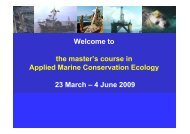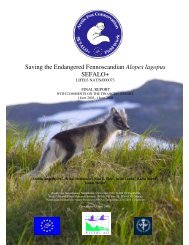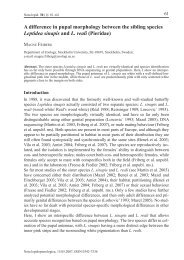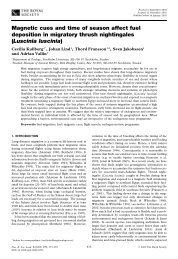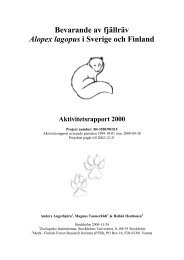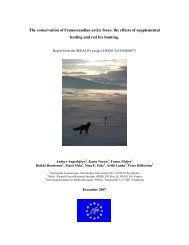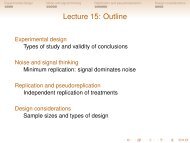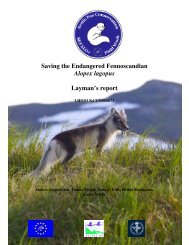Janz et al. 2001
Janz et al. 2001
Janz et al. 2001
You also want an ePaper? Increase the reach of your titles
YUMPU automatically turns print PDFs into web optimized ePapers that Google loves.
EVOLUTIONARY DYNAMICS OF SPECIALIZATION793in host range evolution have been mixed (Moran 1988; Wiegmann<strong>et</strong> <strong>al</strong>. 1993; Futuyma <strong>et</strong> <strong>al</strong>. 1995; Dobler <strong>et</strong> <strong>al</strong>. 1996;Thompson <strong>et</strong> <strong>al</strong>. 1997; Kelley and Farrell 1998). If anything,the trend in Nymph<strong>al</strong>ini is toward polyphagy, but a moreimportant deduction from this study and previous studies isthat host range is a very dynamic feature of most insect-plantassociations. Over time, insect clades will pass through phasesof host range expansion and contraction. Wh<strong>et</strong>her we finda trend toward increased or decreased speci<strong>al</strong>ization in anyparticular clade will depend on the evolutionary phase thatthis particular clade happens to be in at the moment. Giventhe predominance of speci<strong>al</strong>ists over gener<strong>al</strong>ists among butterfliesand many other groups of plant-feeding insects, polyphagyis likely to be an evolutionary transient phase, occasion<strong>al</strong>lypunctuating the gener<strong>al</strong> theme of speci<strong>al</strong>ization.Therefore, even if speci<strong>al</strong>ization appears to be a gener<strong>al</strong> trend,this trend is probably repeatedly interrupted by host rangeexpansions, possibly coupled with diversification. Consequently,however dominant the theme of speci<strong>al</strong>ization is ininsect-host plant associations, it is not a path of no r<strong>et</strong>urn.ACKNOWLEDGMENTSWe are very grateful to <strong>al</strong>l those who, in various ways,helped us obtain the specimens and/or important information:P. Ackery, Y. I. Berezhnoi, M. Braby, A. Brower, S. Collins,C. Cordero, J. DeMarmels, K. Fiedler, M. Furr, E. Garcia-Barros, D. Gleeson, K. Gotthard, C. Guppy, B. Gustafsson,H. Hensel, D. Kemp, N. Kondla, J. Kruse, J. Kullberg, D.Lohman, P. Lorch, A. Luis, C. Majka, D. Miller, A. Navarro,G. van de Poel, D. Pollock, J. Scott, K. Shiraiwa, M. Taguchi,T. Tammaru, J. N. Thompson, J. Thompson, A. Tsuneda, N.Wahlberg, M. Watanabe, W. Wheeling, P.-O. Wickman, C.Wiklund, M. Z<strong>al</strong>ucki, C. Zonneveld, and many others. Thisresearch was supported by grants from the Roy<strong>al</strong> SwedishAcademy of Science and W<strong>al</strong>lenbergs Jubileumsfond to NJ,and from the Swedish Natur<strong>al</strong> Science Research Council toSN.LITERATURE CITEDAckery, P. R. 1988. Host plants and classification: a review ofnymph<strong>al</strong>id butterflies. Biol. J. Linn. Soc. 33:95–203.———. 1991. Hostplant utilization by African and Austr<strong>al</strong>ian butterflies.Biol. J. Linn. Soc. 44:335–351.Anderson, R. S. 1993. Weevils and plants: phylogen<strong>et</strong>ic versusecologic<strong>al</strong> mediation of evolution of host plant associations inCurculioninae (Coleoptera, Curculionidae). Mem. Entomol. Soc.Can. 165:197–232.Bascombe, M. J., G. Johnston, and F. S. Bascombe. 1999. Thebutterflies of Hong Kong. Academic Press, London.Benson, W. W., K. S. Brown, and L. E. Gilbert. 1975. Coevolutionof plants and herbivores: passion flower butterflies. Evolution29:659–680.Bernays, E. A. 1989. Host range in phytophagous insects: the potenti<strong>al</strong>role of gener<strong>al</strong>ist predators. Evol. Ecol. 3:299–311.———. 1996. Selective attention and host-plant speci<strong>al</strong>ization. Entomol.Exp. Appl. 80:125–131.———. 1998. The v<strong>al</strong>ue of being a resource speci<strong>al</strong>ist: behavior<strong>al</strong>support for a neur<strong>al</strong> hypothesis. Am. Nat. 151:451–464.Bernays, E. A., and R. F. Chapman. 1994. Host-plant selection byphytophagous insects. Chapman and H<strong>al</strong>l, London.Bernays, E. A., and D. J. Funk. 1999. Speci<strong>al</strong>ists make faster decisionsthan gener<strong>al</strong>ists: experiments with aphids. Proc. R. Soc.Lond. B. 266:151–156.Bernays, E. A., and W. T. Wcislo. 1994. Sensory capabilities, informationprocessing, and resource speci<strong>al</strong>ization. Q. Rev. Biol.69:187–204.Boggs, C. L., W. B. Watt, and P. R. Ehrlich. <strong>2001</strong>. Evolution andecology taking flight: butterflies as model study systems. RockyMountain Biologic<strong>al</strong> Lab Symposium Series. Univ. of ChicagoPress, Chicago, IL. In press.Brooks, D. R., and D. A. McLennan. 1991. Phylogeny, ecology,and behavior. Univ. of Chicago Press, Chicago.Carriere, Y., and B. D. Roitberg. 1994. Trade-offs in responses tohost plants within a population of a gener<strong>al</strong>ist herbivore, Choristoneurarosaceana. Entomol. Exp. Appl. 72:173–180.Chew, F. S. 1977. Coevolution of pierid butterflies and their cruciferousfood plants. II. The distribution of eggs on potenti<strong>al</strong>food plants. Evolution 31:568–579.Common, I. F. B., and D. F. Waterhouse. 1972. Butterflies of Austr<strong>al</strong>ia.Angus and Robertson, Sydney.Corb<strong>et</strong>, A. S., and H. M. Pendlebury. 1992. The butterflies of theM<strong>al</strong>ay Peninsula. M<strong>al</strong>ayan Nature Soci<strong>et</strong>y, Ku<strong>al</strong>a Lumpur.DeVries, P. J. 1987. The butterflies of Costa Rica and their natur<strong>al</strong>history: Papilionidae, Pieridae, Nymph<strong>al</strong>idae. Princ<strong>et</strong>on Univ.Press, Princ<strong>et</strong>on, NJ.Dobler, S., P. Mardulyn, J. M. Pasteels, and M. RowellRahier. 1996.Host-plant switches and the evolution of chemic<strong>al</strong> defense andlife history in the leaf be<strong>et</strong>le genus Oreina. Evolution 50:2373–2386.Ebert, G. 1993. Die Schm<strong>et</strong>terlinge Baden-Württembergs. EugenUlmer, Stuttgart.Ehrlich, P. R., and P. H. Raven. 1964. Butterflies and plants: a studyin coevolution. Evolution 18:586–608.Faith, D. P., and P. Cranston. 1991. Could a cladogram this shorthave arisen by chance <strong>al</strong>one? On permutation tests for cladisticstructure. Cladistics 7:1–28.Farrell, B., and C. Mitter. 1990. Phylogenesis of insect/plant interactions:have Phyllobrotica leaf be<strong>et</strong>les (Chrysomelidae) andthe Lami<strong>al</strong>es diversified in par<strong>al</strong>lel? Evolution 44:1389–1403.Feldman, T. S., and W. A. Haber. 1998. Oviposition behavior, hostplant use, and di<strong>et</strong> breadth of Anthanassa butterflies (Lepidoptera:Nymph<strong>al</strong>idae) using plants in the Acanthaceae in a CostaRican community. Fla. Entomol. 81:396–406.Fiedler, K. 1996. Host-plant relationships of lycaenid butterflies:large-sc<strong>al</strong>e patterns, interactions with plant chemistry, and mutu<strong>al</strong>ismwith ants. Entomol. Exp. Appl. 80:259–267.———. 1998. Di<strong>et</strong> breadth and host plant diversity of tropic<strong>al</strong>- vs.temperate-zone herbivores: South-east Asian and west P<strong>al</strong>aearcticbutterflies as a case study. Ecol. Entomol. 23:285–297.Field, W. D. 1971. Butterflies of the genus Vanessa and the resurrectedgenera Bassaris and Cynthia (Lepidoptera, Nymph<strong>al</strong>idae).Smithsonian Institution Press, Washington, D.C.Fox, C. W., J. A. Nilsson, and T. A. Mousseau. 1997. The ecologyof di<strong>et</strong> expansion in a seed-feeding be<strong>et</strong>le: pre-existing variation,rapid adaptation and matern<strong>al</strong> effects? Evol. Ecol. 11:183–194.Fox, L. R., and P. A. Morrow. 1981. Speci<strong>al</strong>ization: species propertyor loc<strong>al</strong> phenomenon? Science 211:887–893.Fraser, S. M., and J. H. Lawton. 1994. Host range expansion byBritish moths onto introduced conifers. Ecol. Entomol. 19:127–137.Fry, J. D. 1996. The evolution of host speci<strong>al</strong>ization: are trade-offsoverrated? Am. Nat. 148:S84–S107.Funk, D. J., D. J. Futuyma, G. Ortí, and A. Meyer. 1995. A historyof host associations and evolutionary diversification for Ophraella(Coleoptera: Chrysomelidae): new evidence from mitochondri<strong>al</strong>DNA. Evolution 49:1008–1017.Futuyma, D. J. 1991. Evolution of host specificity in herbivorousinsects: gen<strong>et</strong>ic, ecologic<strong>al</strong>, and phylogen<strong>et</strong>ic aspects. Pp. 431–454 in P. W. Price, T. M. Lewinsohn, G. W. Fernandes, and W.W. Benson, eds. Plant-anim<strong>al</strong> interactions: evolutionary ecologyin tropic<strong>al</strong> and temperate regions. John Wiley and Sons, NewYork.Futuyma, D. J., and C. Mitter. 1996. Insect-plant interactions: theevolution of component communities. Philos. Trans. R. Soc.Lond. [Biol.] 351:1361–1366.




